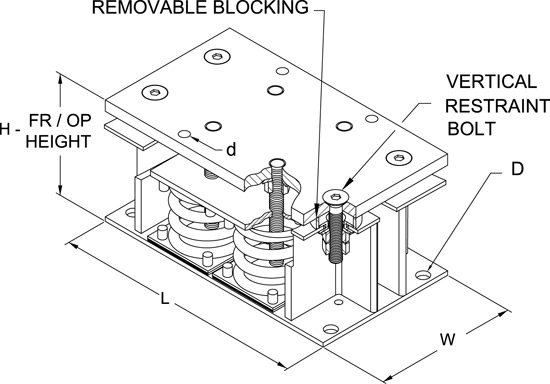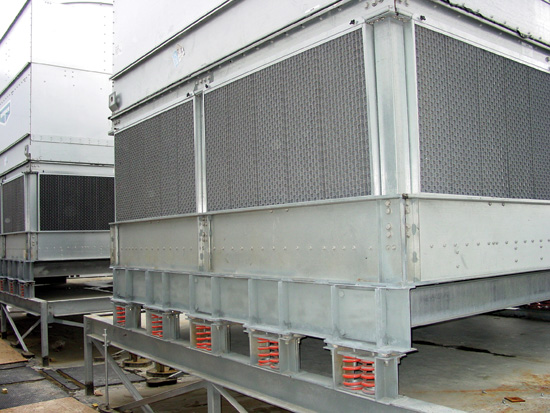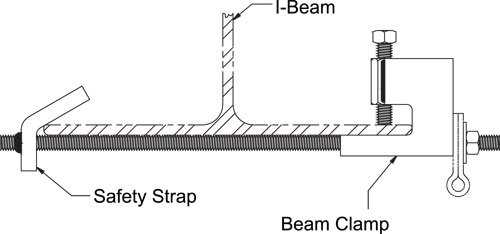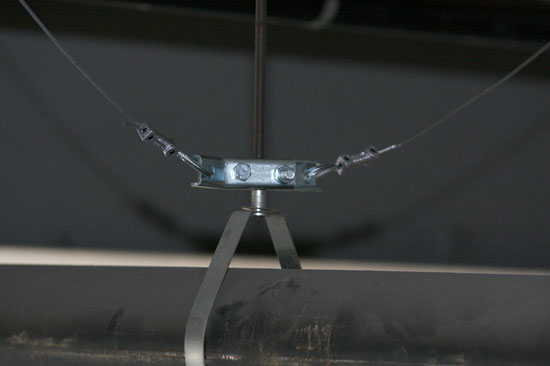Understanding Seismic and Wind Restraints
It is most cost effective to locate heavy equipment at lower levels within the building envelope wherever feasible. However, as recent disasters such as Hurricane Sandy have shown, serious damage resulting from flooded equipment located on grade or below, far outweighs the savings from installing equipment on lower levels.
 |
 |
Typical rooftop plate-type three-axis seismic restraint can be specified for isolating equipment carrying a large fluid load, which may be drained, such as boilers and chillers. Photo courtesy of Kinetics Noise Control |
Anchorage of Pipe and Duct to Concrete
Concrete has long been identified as a weak point when used in areas exposed to seismic events. The addition of anchorage holes in the concrete provides locations for stress cracks to develop. These cracks open up and allow conventional anchors to easily pull out. Because of the requirement, post-installed seismically rated anchors are required. Both 2006 IBC and 2009 IBC require that the concrete anchors for seismic applications must be pre-qualified per ACI (American Concrete Institute) 355.2 (ICC AC 193 (International Code Council Acceptance Criteria) and have an ICC-ESR Evaluation Service report. Ratings vary by size and by anchor manufacturer. It is critical that the restraint system design specifies a particular anchor by size and source and that the anchor used conforms to this specification.
Additional Anchorage Limitations
Fasteners that rely on friction that results from gravity-based forces are not permitted to be used for seismic restraints. These include:
- Power-actuated fasters, such as powder shot pins. These fasteners rely on the elastic nature of the material into which they are driven to provide enough friction force to prevent withdrawal under a tensile load. During a seismic event, vibration may cause them to back out.
- Non-qualified friction clips which rely on friction for their holding power.
- Friction due to gravity loads.
- Drop-in-concrete anchors with an internal thread and expansion core.
 |
A beam clamp may be used for restraint if it includes a safety strap. Drawing courtesy of Kinetics Noise Control |
Beam Clamps
Typical beam clamps rely strongly on friction to hold their position and are designed to support primarily vertical loads. However, if they include a safety strap that can resist a seismic load, they may be used for restraint.
Mechanical Equipment Over 10 HP
The 2006 and 2009 IBC require that non-isolated mechanical equipment over 10 HP will require undercut anchors that fit into a groove cut at the base of the anchor pocket, or anchors that are adhered in the anchor pocket using a seismically qualified adhesive material.
Housekeeping Pads
Housekeeping pads are often added to increase slab thickness in order to provide a reasonable embedment depth for larger diameter anchors and to allow clear areas around equipment for maintenance and cleaning.
- Since the code requires that anchors be embedded in a monolithic pour, the pad must be poured concurrently with the structural floor slab, or that a separate pad is added that is independently thick enough to meet the requirement (more common).
- The housekeeping pad must be adequately reinforced and doweled to the structural slab with sufficient connections to ensure that it will neither shatter nor come loose from the floor during a seismic event.
 |
Example of a connector that fastens cables used in the seismic restraint of piping, duct, electrical cable trays, and suspended equipment. Photo courtesy of Kinetics Noise Control |
Helpful Rules for Restraining Pipe and Duct
Failures in piping systems due to code non-compliance that have led to the release of water or other fluids have been found to be the cause of most of the monetary damage to buildings and contents during seismic events.









